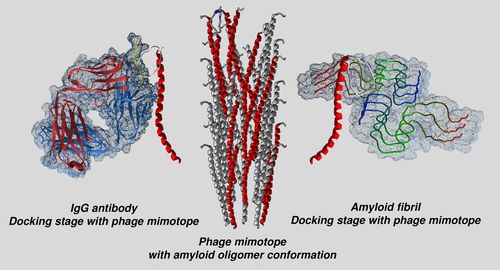当前位置:
X-MOL 学术
›
ACS Chem. Neurosci.
›
论文详情
Our official English website, www.x-mol.net, welcomes your
feedback! (Note: you will need to create a separate account there.)
Innovative IgG Biomarkers Based on Phage Display Microbial Amyloid Mimotope for State and Stage Diagnosis in Alzheimer's Disease.
ACS Chemical Neuroscience ( IF 4.1 ) Pub Date : 2020-03-24 , DOI: 10.1021/acschemneuro.9b00549 Laura M De Plano 1 , Santina Carnazza 1 , Domenico Franco 1 , Maria Giovanna Rizzo 1 , Sabrina Conoci 2, 3 , Salvatore Petralia 2 , Alessandra Nicoletti 4 , Mario Zappia 4 , Michela Campolo 1 , Emanuela Esposito 1 , Salvatore Cuzzocrea 1 , Salvatore P P Guglielmino 1
ACS Chemical Neuroscience ( IF 4.1 ) Pub Date : 2020-03-24 , DOI: 10.1021/acschemneuro.9b00549 Laura M De Plano 1 , Santina Carnazza 1 , Domenico Franco 1 , Maria Giovanna Rizzo 1 , Sabrina Conoci 2, 3 , Salvatore Petralia 2 , Alessandra Nicoletti 4 , Mario Zappia 4 , Michela Campolo 1 , Emanuela Esposito 1 , Salvatore Cuzzocrea 1 , Salvatore P P Guglielmino 1
Affiliation

|
An innovative approach to identify new conformational antigens of Aβ1–42 recognized by IgG autoantibodies as biomarkers of state and stage in Alzheimer’s disease (AD) patients is described. In particular, through the use of bioinformatics modeling, conformational similarities between several Aβ1–42 forms and other amyloid-like proteins with F1 capsular antigen (Caf1) of Yersinia pestis were first found. pVIII M13 phage display libraries were then screened against YPF19, anti-Caf1 monoclonal antibody, and IgGs of AD patients, in alternate biopanning cycles of a so-called “double binding” selection. From the selected phage clones, one, termed 12III1, was found to be able to prevent in vitro Aβ1–42-induced cytotoxicity in SH-SY5Y cells, as well as to promote disaggregation of preformed fibrils, to a greater extent with respect to wild-type phage (pC89). IgG levels detected by 12III1 provided a significant level of discrimination between diseased and nondemented subjects, as well as a good correlation with the state progression of the disease. These results give significant impact in AD state and stage diagnosis, paving the way for the development not only for an innovative blood diagnostic assay for AD precise diagnosis, progressive clinical assessment, and screening but also for new effective treatments.
中文翻译:

基于噬菌体展示微生物淀粉样多肽的创新性IgG生物标记物,用于阿尔茨海默氏病的状态和阶段诊断。
描述了一种创新方法,该方法可识别被IgG自身抗体识别为Alzheimer病(AD)患者状态和阶段的生物标志物的Aβ1–42的新构象抗原。特别是,通过使用生物信息学建模,首先发现了几种Aβ1–42形式与其他淀粉样蛋白与鼠疫耶尔森氏菌F1荚膜抗原(Caf1)的构象相似性。然后,在所谓的“双重结合”选择的交替生物淘选周期中,针对AD患者的YPF19,抗Caf1单克隆抗体和IgG筛选pVIII M13噬菌体展示文库。从所选择的噬菌体克隆,一个,称为12III1,被认为是能够防止在体外Aβ 1-42相对于野生型噬菌体(pC89)在更大程度上在SH-SY5Y细胞中诱导了细胞毒性,并促进了预先形成的原纤维的分解。由12III1检测到的IgG水平在患病和未患痴呆的受试者之间提供了显着水平的区分,并且与疾病状态发展具有良好的相关性。这些结果对AD状态和阶段诊断产生了重大影响,不仅为开发用于AD精确诊断,进行性临床评估和筛查的创新血液诊断测定方法的开发铺平了道路,而且为新的有效疗法铺平了道路。
更新日期:2020-03-24
中文翻译:

基于噬菌体展示微生物淀粉样多肽的创新性IgG生物标记物,用于阿尔茨海默氏病的状态和阶段诊断。
描述了一种创新方法,该方法可识别被IgG自身抗体识别为Alzheimer病(AD)患者状态和阶段的生物标志物的Aβ1–42的新构象抗原。特别是,通过使用生物信息学建模,首先发现了几种Aβ1–42形式与其他淀粉样蛋白与鼠疫耶尔森氏菌F1荚膜抗原(Caf1)的构象相似性。然后,在所谓的“双重结合”选择的交替生物淘选周期中,针对AD患者的YPF19,抗Caf1单克隆抗体和IgG筛选pVIII M13噬菌体展示文库。从所选择的噬菌体克隆,一个,称为12III1,被认为是能够防止在体外Aβ 1-42相对于野生型噬菌体(pC89)在更大程度上在SH-SY5Y细胞中诱导了细胞毒性,并促进了预先形成的原纤维的分解。由12III1检测到的IgG水平在患病和未患痴呆的受试者之间提供了显着水平的区分,并且与疾病状态发展具有良好的相关性。这些结果对AD状态和阶段诊断产生了重大影响,不仅为开发用于AD精确诊断,进行性临床评估和筛查的创新血液诊断测定方法的开发铺平了道路,而且为新的有效疗法铺平了道路。











































 京公网安备 11010802027423号
京公网安备 11010802027423号